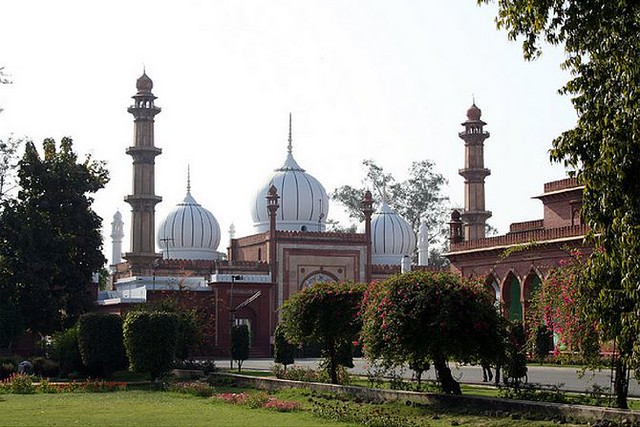Metaphor for Muslims: The kind of tolerance practiced here is, possibly, unparalleled in the world with green, white and black caps shining together, five times a day.
By Mujahid I Mughal,
The greatest tragedy that Muslims today are facing is not their poor socio-economic conditions, least educational advancement and insignificant technological development but acute disintegration and vanished Muslim brotherhood.
It is very common to listen to various preachers and scholars saying that every fourth person is a Muslim in the world or Muslims constitute more than 20 % of the population of the world. But on the ground, the situation is different.

Sir Syed Mosque, Aligarh Muslim University
There is a Fatwa imposed by almost every school of thought, which declares the rest as Kafir in one form or the other. Mere ideological differences are natural and acceptable too, but this is much more than that. Muslims throughout the world have indeed become a victim of casteism and sectarianism representing almost zero tolerance for the fellow Muslims.
Taking an example from India, we see that Indian Muslims might ignore the caste factor inside the mosque for a few hours during the prayers, but outside the mosques Iqbal’s Mahmood and Ayaz have different lives, different societies.
Outside the mosque, in practical life, they again become Syeds, Khans, Mughals, Ansaris and so on. One example of this dominant casteism in Muslims, like Hindus, is the meagre incidence of inter caste marriages.
It becomes worse than casteism, when it is about ideological differences with regard to the interpretations of religion. It is very common now-a-days to see more than one mosque – sometimes three to four mosques built next to each other – even in those Muslim localities where even one mosque is more than enough. These edifices, unfortunately, are not built to accommodate more and more people but to exhibit differences, to exhibit intolerance.
There are also verdicts of different schools of thought which make it compulsory for their followers to boycott other Muslims completely. Not only this, there have happened many incidents where a mosque was washed and purified (as they believed) after some Muslims belonging to a different school of thought entered and prayed inside. The school of thought has also become a basic criterion for most marriages in the Muslim community. To get back into the sect, many had to proclaim Shahadah once again.
Be it India, Pakistan, Iraq or anywhere else in the world, this narrow-mindedness is at its zenith. It has ruined the Muslim society at large. It has affected Muslims more than anything else, more than anyone else. Many have used this intolerance for their vested interests too. Others used it as a political gimmick. Still many others were carried away with this ignorance. Muslim history shows this intolerance alone has been one of the chief causes for their political downfall, for their social downfall. Possibly it was the greatest cause.
Also, if we look keenly, beside other factors, three important factors which are very much responsible for this disintegration of the Muslim society are misinterpretation and misunderstanding of religion, throwing of issues which are very much scholarly in nature in the masses, and last but not the least, the insignificant efforts by the respective leaders of various schools of thought to bridge this gap.
This intolerance and bigotry then came to the surface in the form of violence and crime. Sectarian killings in Iraq by Shias and Sunnis are the manifestation of this intolerance. Sectarian clashes in Pakistan are another example. Apart from it there is a history of other sectarian clashes all over.
Sir Syed Mosque – a ray of hope
However, in the midst of this chaos, Sir Syed Mosque at the Aligarh Muslim University (AMU) is a ray of hope. Adjacent to the historical Stretchy Hall, Sir Syed Mosque poses a striking view for the onlookers. The Mosque has been a great tourist attraction since long for people belonging to all faiths and all walks of life from all over the world. Tomb of Sir Syed Ahmed Khan, founder of Aligarh Muslim University, within the boundary of mosque makes it a tourist hub indeed.
This mosque in its apparent architectural beauty is believed to be similar to the Mughal Badshahi Mosque of Lahore and Jamia Mosque Delhi. But the kind of tolerance practiced here is, possibly, unparalleled in the world. It is here, one can see green, white and black caps shining together, five times a day.
On can also notice the picturesque magnanimity and tolerance while seeing the believers who fold their hands at chest, below navel, above navel and those who do not fold hands at all. All under one roof! It is possibly the only mosque where tolerance in literal and true sense prevails. It has indeed become an epitome of human brotherhood in general and Muslim brotherhood in particular, practising literally the words, “Oh the people of Book, Come to the common terms as between us and You (Quran)”.
Sir Syed Mosque, the Grand Mosque of Aligarh Muslim University, has a lot to say to those who have eyes and ears. To those who have minds and hearts.
——-
(Mujahid I Mughal is a PhD scholar from the Department of Geography at the Aligarh Muslim University. He can be reached at [email protected] )
